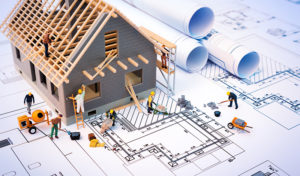Most homeowners associations establish an Architectural Review Board to maintain the aesthetics of their communities. Homeowners living in such communities should be aware of the process of obtaining approval from this board before starting any home improvement plans.
The Role of the Architectural Review Board in an HOA Community
Homeowners associations are known for many things, but perhaps one of the most apparent is their commitment to upholding strict rules when it comes to individual architectural changes, particularly external ones. In a setting outside of an HOA, homeowners typically have total control over their homes. They can change anything they want — from the paint color to the plants in their front yard. The same can’t be said, though, for homeowners living in HOA communities.
Both state laws and an association’s governing documents grant the HOA the authority to create and enforce rules for the good of the community. In fact, courts across the country have, time and again, confirmed the power of HOAs to impose architectural rules and limitations.
Of course, these rules and restrictions should not conflict with federal and state laws. For example, California law prohibits homeowners associations from banning the installation of solar panels. Similar solar access laws exist in other states, too. Other than that, architectural rules should be reasonable and remain within the best interests of the community.
The job of reviewing architectural changes and applications usually falls to the HOA board, particularly in smaller communities. But, many other communities form an Architectural Review Board (ARB) or Architectural Review Committee (ARC) to fulfill this responsibility. In addition to reviewing proposals, the ARB or ARC is also in charge of adopting new guidelines and inspecting homes for any violations. Such a committee usually consists of a mix of current board members and other volunteer homeowners.
What HOA Home Improvements Require Approval?
 In general, homeowners can make any interior changes to their homes without obtaining approval from Architectural Review Boards. But, if it is an external change or if the internal change will affect the external appearance of their home, they will usually need to go through the ARB. Condominiums, in particular, tend to have more stringent standards and restrictions because there are more common elements.
In general, homeowners can make any interior changes to their homes without obtaining approval from Architectural Review Boards. But, if it is an external change or if the internal change will affect the external appearance of their home, they will usually need to go through the ARB. Condominiums, in particular, tend to have more stringent standards and restrictions because there are more common elements.
Keep in mind that every community will have its own set of architectural standards depending on its governing documents and state laws. While these guidelines can vary, some examples include the following:
1. Paint Colors
More often than not, an association will regulate the color of individual houses. Associations may only allow specific colors or shades, or they may require owners to follow a certain theme.
2. Windows and Doors
It is common for homeowners in older communities to want to replace their windows with more energy-efficient ones. But, given that there are countless designs for windows and doors, it makes sense for an HOA to regulate them as well. For example, if a community consists mainly of Victorian houses, then the windows and doors owners choose should match this aesthetic.
3. Decks, Sheds, and Fences
For external HOA home renovations such as sheds, fences, and decks, associations will typically have guidelines pertaining to the height and width allowed. These associations may also only allow certain materials and colors.
4. Landscaping and Plants
While some HOAs simply require owners to keep their yards neat, others will make landscaping mandatory. This is more common in wealthier communities. Associations might only allow specific trees or plants, landscaping materials, grass length, and irrigation methods.
What Homeowners Should Do to Get Approval
 There is no universal ARB review process that applies to all homeowners or condo associations. The exact steps involved in the approval process can vary from one community to another. Homeowners will typically find details of the procedure within the community’s governing documents, either in the CC&Rs or the operating rules.
There is no universal ARB review process that applies to all homeowners or condo associations. The exact steps involved in the approval process can vary from one community to another. Homeowners will typically find details of the procedure within the community’s governing documents, either in the CC&Rs or the operating rules.
In general, the approval process begins with a submission of the project details. Homeowners will have to fill out an application form along with any supporting documents or designs. The Architectural Review Board will then examine the proposal and determine if it meets the community’s standards. If it does, then the homeowner can expect a positive decision, which usually comes with written approval. If the plans don’t coincide with the community’s standards, the homeowner will typically receive a rejection letter, which includes the reasoning behind the decision.
Architectural Review Boards should always make unbiased and uniform decisions. Selective enforcement can lead to a whole host of problems, including potential liability.
Following the completion of the approved plans, the ARB will normally perform a final review of the finished project. The committee does this to ensure that the actual changes match the plans that were approved. For more intricate projects, the ARB may wish to inspect the construction every so often. This way, the committee can make any violations known early on.
What Happens If Homeowners Don’t Get Approval?
While most homeowners follow their HOA’s rules to the letter, there are those that treat compliance as optional. If a homeowner proceeds with a project without securing the approval it needs, homeowners associations do have the power to halt it.
Most associations will start by sending a written letter asking the homeowner to stop the construction until they obtain approval. They may also ask the homeowner to reverse any changes already made, at the homeowner’s own expense. Other available enforcement options include imposing a fine or revoking access to common amenities.
More often than not, the above recourses will work just fine. But, some hard-headed homeowners will continue the project even when faced with consequences. In that case, the HOA may file a civil lawsuit and seek an injunction against the homeowner. This injunction can include an order to restore the property to its condition prior to the architectural changes.
Homeowners stand to gain nothing from skipping the HOA architectural review. In fact, there are many penalties, both monetary and otherwise, that homeowners might face if they ignore the community’s rules. It can even go as far as earning local jail time.
For Everyone’s Benefit
The Architectural Review Board serves a significant purpose in the preservation of curb appeal and property values in an HOA community. While it may seem tedious to go through a formal approval process, homeowners should remember that it is all for the good of the association and its members.
Is your HOA or condo board having a hard time enforcing your architectural standards and reviewing applications? Seek help from Clark Simson Miller! Email us today at help@csmhoa.com, or contact us online to learn more about our services.
RELATED ARTICLES:
- The Ultimate HOA Architectural Review Guide
- HOA Holiday Decoration Rules And Guidelines
- Can The HOA Restrict Homeowners From Flying The U.S. Flag On Memorial Day?

